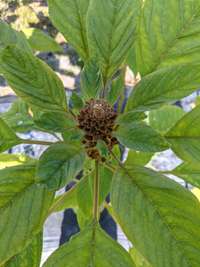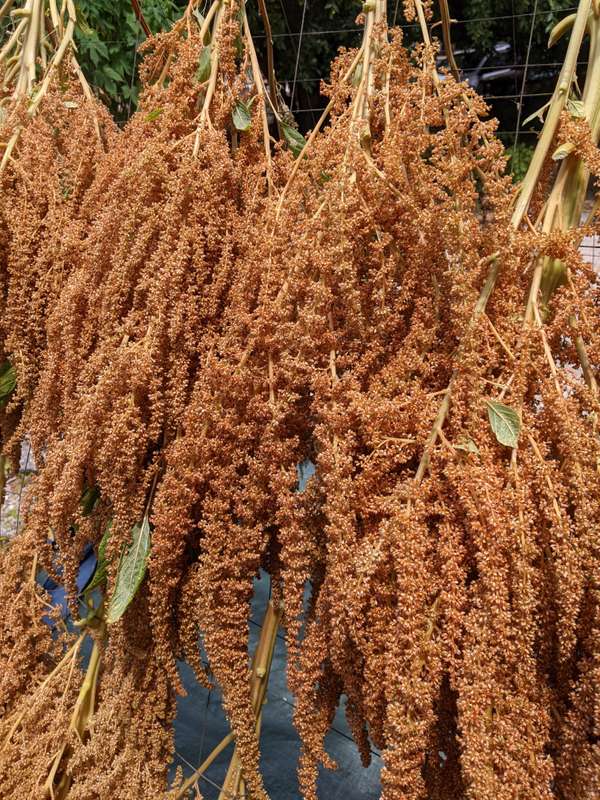
Figure 7. Young flower of ‘PI606767‘ A. cruentus. Source: Holly Sobetski
Amaranthus is native to Guatemala and Mexico. This diverse genus comprises many varieties and cultivars now found worldwide. Amaranth species are used for leafy vegetables, as “pseudo-grains,” for food, and as ornamentals. ECHO’s seedbank variety, Amaranthus cruentus ‘PI606767’ (Figures 7 and 8), is a nutritious grain amaranth with drought resistance, low fertility requirements, and resistance to plant diseases and pests which make this Amaranth variety an ideal crop for climate adaptation. Other weedy species like A. retroflexus (redroot pigweed), A. palmeri (Palmer amaranth), A. spinosus (spiny amaranth) and A. albus (the famous tumbleweed; Thapa and Blair, 2018) are often confused with the useful grain species.
Climate
Suitable growing climates range from temperate to tropical regions of both hemispheres that are both semi-arid and humid. Adapted to many latitudes, temperature requirements are the primary factors for cultivation, with seed germination being the most affected property. In South Africa, both A. hypochondriacus and A. cruentus germinated well at 28°C but A. hypochondriacus germinated much better than A. cruentus at 12°C indicating that A. hypochondriacus is best for cooler temperatures (Loonat et al., 2003).
Cultivation

Figure 8. Mature A. cruentus grain heads drying down. Source: Holly Sobetski
The small seeds of A. cruentus (the mass of 1000 seeds is around 0.70 to 0.82 g) are 0.9 to 1.7 mm in diameter (Gomes et al., 2023b) and planted at a depth of 5 to 20 mm. Because the seeds are so small they have minimal stored energy for germination. Any impediment, like excess depth or topsoil crusting, lowers germination rates. Amaranth prefers loamy soil (Gomes et al., 2023a) but germinates in finer textured soils under natural conditions (without irrigation) due to increased moisture retention. A planting density of 166,666 plants/ha (30 x 20 cm) is optimal for general production (Gomes et al., 2023b); while (Olofintoye et al., 2015) found a planting density of 60,000 was optimal for fertilized grain production. A. cruentus responds well to nitrogen, with the optimum nitrogen (N) recommendation of 67.5 kg N per ha (Makinde et al., 2011). The increase in leaf biomass from increased fertilization makes amaranth more susceptible to drought (Cechin et al., 2022) because of higher evapotranspiration rates.
Pests
Pests include amaranth stem weevils (Hypolixus truncatulus), beetworm moths (Spoladea recurvalis), leafminers (Liriomyza huidobrensis), and aphids (Aphidoidea)) (Seni, 2018). H. nubilosus and Cletus spp. are common pests; (Kagali 2014; Seni 2018) with A. cruentus being the most susceptible of all the amaranths studied (Kagali 2014; Ogedegbe and Ezeh 2015).
Researching pest incidence and manures in A. cruentus, Ogedegbe and Ezeh (2015), found presence of Muscidae (presumably in the manure treatments) and the attraction of non-typical pest species like Mantidae, so considering local conditions is important. Opportunistic and temporal pests like grasshoppers present in the crop can cause leaf damage and vector plant diseases.
Vermeulen et al., (2018) found stem weevils A. dodonis, Bardine amaranthi, and H. haerens, to also be vectors of fusarium. Alternaria leaf spot affects amaranth leaves when vectored by pests and alternatively hosted in other crops.
Culinary and Nutrition
Popular in granola, grain amaranth gives a nutty flavor when added to bread and cereals. Although vegetable varieties may be more palatable, you can consume the tender growth of the leaves and stems of grain varieties as well. Gluten-free, grain amaranth is useful for diets for people with the autoimmune disorder celiac disease and those wishing to adopt a gluten-free diet. Table 1 contains nutritional information about amaranth flour.
| Nutrient | Amount | % of recommended daily intake* |
|---|---|---|
| Vitamins | ||
| Thiamin | 0.059 mg/100 g | 20 |
| Riboflavin | 0.175 mg/100 g | 13 |
| Niacin | 0.748 mg/100 g | -- |
| Vitamin B-6 | 0.387 mg/100 g | 26 |
| Biotin | 25.4 μg | 85 |
| Minerals | ||
| Iron | 7.56 mg/100 g | 95 |
| Magnesium | 233 mg/100 g | 55 |
| Phosphorus | 425 mg/100 g | 60 |
| Zinc | 3 mg/100 g | 27 |
| *These values are for adults. Pregnant and breastfeeding women have higher needs so consult a certified nutritionist or medical professional for further information. | ||
References
Cechin, I., L.P. da Silva, E.T. Ferreira, S.C. Barrochelo, F.P.D.S.R. de Melo, A.L. Dokkedal, and L.L. Saldanha. 2022. Physiological responses of Amaranthus cruentus L. to drought stress under sufficient-and deficient-nitrogen conditions. PlosOne. 17(7), e0270849. https://doi.org/10.1371/journal.pone.0270849
Gomes, V., L.E. Lindsey, and R.O. Mesquita. 2023a. Effect of soil type and sowing depth on the germination and early growth of two grain amaranth cultivars. Agrosystems, Geosciences & Environment, 6, e20386. https://doi.org/10.1002/agg2.20386
Gomes, V., R.O. Mesquita, L.R. Nunes, and R. Innecco. 2023b. Agronomic performance of grain amaranth in the semi-arid region as a function of the planting arrangement. Rev. Caatinga, v.37: e11913, http://dx.doi.org/10.1590/1983-21252024v3711913rc
Kagali, R.N. 2014. An integrated pest management approach of amaranth insect pests in Buuri District, Meru County, Kenya (Doctoral dissertation, M. Sc. thesis, Jomo Kenyatta University of Agriculture and Technology, Juja, Kenya).
Loonat, TA, E. Heever, and P. Hammes. 2003. Effect of temperature on the germination of grain amaranth. South African Journal of Plant and Soil, 20(3): 152-164.
Makinde, E.A., L.S. Ayeni, and S.O Ojeniyi. 2011. Effects of organic, organomineral and NPK fertilizer treatments on the nutrient uptake of Amaranthus cruentus (L.) on two soil types in Lagos, Nigeria. Journal of Central European Agriculture, 12(1): 114-123.
Ogedegbe, A.B.O. and A.E. Ezeh. 2015. Effect of variety and nutrient on insect pest infestation of Amaranthus spp. J. Appl. Sci. Environ. Manage, 19 (2): 251-256.
Olofintoye, J.A.T., Y.A. Abayomi, and O. Olugbemi. 2015. Yield responses of grain amaranth (Amaranthus cruentus L.) varieties to varying planting density and soil amendment. African Journal of Agricultural Research, 10(21): 2218-2225.
Seni, A. 2018. Insect pests of amaranthus and their management. International Journal of Environment, Agriculture and Biotechnology, (3)3. http://dx.doi.org/10.22161/ijeab/3.3.50
Thapa, R., and M.W. Blair. 2018. “Morphological Assessment of Cultivated and Wild Amaranth Species Diversity” Agronomy, 8(11): 272. https://doi.org/10.3390/agronomy8110272
USDA. 2015. National Nutrient Database. United States Department of Agriculture.
Vermeulen, M., S. Louw, G.J. Marais, W.J. Weeks, W.J. Swart, and M. Gryzenhout. 2018. Fungi associated with disease and weevil damage of Amaranthus cruentus in South Africa. African Entomology 26(1): 174–188. https://doi.org/10.4001/003.026.0174.